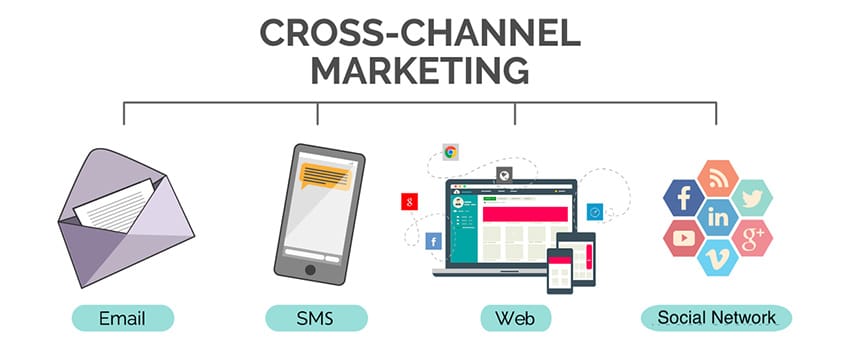
Are you ready to revolutionize your marketing strategy and dominate your industry in 2023? Look no further! In this comprehensive guide, we’ll unveil 12 proven cross-channel marketing strategies that will transform your approach and skyrocket your ROI.
Cross-channel marketing is the key to creating seamless customer experiences in today’s digital age. By integrating multiple channels, you’ll boost brand awareness, maximize engagement, and foster unparalleled customer loyalty.

Cross-Channel Marketing: Definition and Importance
In today’s digital age, the way we shop has drastically changed. Imagine you’re browsing Instagram and spot a cool pair of sneakers. You click the ad, check out the website, but don’t buy right away. Later, you see a Facebook ad for the same shoes and decide to visit the physical store. Finally, you make the purchase online using a discount code from an email. This, my friend, is cross-channel marketing in action!
Cross-channel marketing is like a well-orchestrated symphony. It’s a strategy where businesses use multiple interconnected marketing channels to create a seamless customer journey. Unlike single-channel marketing, which is like playing a solo instrument, cross-channel marketing brings together various platforms to create a harmonious experience.
Why is this important? Well, think about your own shopping habits. You probably use different devices and platforms throughout your day, right? Maybe you start your morning scrolling through Instagram, check emails on your lunch break, and browse online stores in the evening. Cross-channel marketing ensures that no matter where you are in your customer journey, the brand is right there with you.
In the digital age, consumers expect a consistent experience across all touchpoints. They want to start a conversation on Twitter, continue it via email, and finalize it in-store without missing a beat. Cross-channel marketing makes this possible by creating a cohesive brand story across all platforms.
Moreover, this approach allows businesses to reach their target audience more effectively. By being present on multiple channels, brands increase their chances of connecting with potential customers at the right time and place. It’s like casting a wider net, but with precision and purpose.
Differences Between Cross-Channel, Multichannel, and Omnichannel Marketing
Now, let’s clear up some confusion. You might have heard terms like multichannel and omnichannel marketing thrown around. While they’re related to cross-channel marketing, there are some key differences.
Multichannel Marketing
Imagine a store that sells products in-store, online, and through a catalog. That’s multichannel marketing. It’s about being present on multiple platforms, but each channel operates independently.
Cross-Channel Marketing
Cross-channel marketing takes it a step further. It’s like a relay race where the baton (customer data) is passed seamlessly between channels. For example, a customer might see a TV ad, research the product on social media, and then make a purchase online. The marketing strategy is coordinated across these different channels.
Omnichannel Marketing
Omnichannel is the gold standard. It’s like a perfectly synchronized dance where all channels move together. It provides a fully integrated experience, regardless of where or how a customer interacts with the brand. Think of Amazon, where your cart follows you from the app to the website to Alexa.
While all these strategies involve multiple channels, the level of integration and seamlessness increases from multichannel to cross-channel to omnichannel. Cross-channel sits in the sweet spot, offering integration without the complexity of a full omnichannel approach.
Benefits of Cross-Channel Marketing
Cross-channel marketing isn’t just a fancy buzzword; it’s a powerhouse strategy that can supercharge your business. Let’s dive into some of its game-changing benefits:
Boosted Brand Awareness
Imagine your brand as a catchy pop song. The more places people hear it, the more likely they are to remember it, right? Cross-channel marketing works the same way. By appearing consistently across multiple platforms, you’re increasing your chances of getting stuck in your audience’s head.
Laser-Focused Targeting
With cross-channel marketing, you’re not just throwing spaghetti at the wall and hoping it sticks. You’re using data from various channels to build a detailed picture of your target audience. This allows you to tailor your messages with sniper-like precision.
Skyrocketing Engagement
When you meet your customers where they are, magic happens. Cross-channel marketing allows you to engage with your audience on their preferred platforms, increasing the likelihood of interaction. It’s like speaking their language, on their turf.
Customer Loyalty on Steroids
Ever had a friend who always seems to know exactly what you need? That’s what cross-channel marketing does for your customers. By providing a consistent, personalized experience across channels, you’re building a relationship that keeps them coming back for more.
Proven ROI That'll Make Your CFO Smile
Here’s the cherry on top: cross-channel marketing delivers results. Studies show that cross-channel customers have a 30% higher lifetime value compared to single-channel customers. That’s not just a win; it’s a home run for your bottom line.
Building a Winning Cross-Channel Marketing Strategy
Creating a killer cross-channel marketing strategy is like assembling a superstar team. Each player has a crucial role, and when they work together, magic happens. Let’s break down the key players in your cross-channel dream team:
Defining Buyer Personas
First up, we have the scout: your buyer personas. These are detailed profiles of your ideal customers. They’re not just demographics; they’re deep dives into your customers’ hopes, fears, and behaviors.
For example, meet “Tech-Savvy Tina,” a 28-year-old urban professional who values convenience and stays up-to-date with the latest gadgets. She’s always on her smartphone and prefers brands that offer seamless digital experiences.
By creating detailed personas like Tina, you can tailor your marketing efforts to resonate with your real-world customers.
Selecting Appropriate Channels
Next, we have the strategist: channel selection. This is about choosing the right platforms to reach your audience. It’s not about being everywhere; it’s about being where your customers are.
For Tina, this might mean focusing on Instagram and LinkedIn rather than Facebook or traditional TV ads. Maybe she’s also a podcast junkie, so audio ads could be effective.
Remember, each channel should play a specific role in your customer’s journey.
Unifying Data Across Platforms
Now, meet the analyst: data unification. This player collects and connects data from different platforms to create a comprehensive view of your customers.
For instance, you might discover that Tina first interacts with your brand through an Instagram ad, then visits your website via her mobile phone, and finally makes a purchase on her laptop. By unifying this data (with user consent, of course), you can create a more personalized experience for Tina.
Aligning Content with the Buyer's Journey
Our content creator is up next. This player ensures that your content matches each stage of the buyer’s journey.
For Tina, you might start with awareness-stage content on Instagram showcasing your product’s innovative features. As she moves down the funnel, you could retarget her with more detailed product comparisons on LinkedIn. Finally, you might seal the deal with an email offering a limited-time discount.
Leveraging Social Media Effectively
Last but not least, we have the social media guru. This player knows how to make your brand shine on platforms like Facebook, Instagram, and Twitter.
For Tina, this might mean creating engaging Instagram Stories that highlight your product’s tech features, or running a targeted LinkedIn campaign that positions your brand as a must-have for young professionals.
Remember, social media isn’t just about promotion; it’s about building relationships and providing value.
Measuring and Analyzing Cross-Channel Marketing Success
You’ve launched your cross-channel marketing campaign, and it’s running smoothly. But how do you know if it’s actually working? This is where measuring and analyzing come into play. It’s like being a detective, piecing together clues to solve the mystery of your marketing success.
Key Performance Indicators (KPIs) for Cross-Channel Marketing
First things first, you need to know what to measure. Here are some key performance indicators (KPIs) that can help you gauge the success of your cross-channel marketing efforts:
- Conversion Rate: This is the percentage of visitors who take a desired action (like making a purchase or signing up for a newsletter). A good rule of thumb is to aim for a conversion rate of 2-5% for e-commerce sites.
- Click-Through Rate (CTR): This measures how many people clicked on your ad or link. The average CTR for Facebook ads across all industries is 0.90%.
- Customer Lifetime Value (CLV): This predicts the total revenue a business can expect from a single customer account. Increasing CLV by just 5% can increase profits by 25-95%.
- Return on Investment (ROI): This measures the profitability of your marketing efforts. A good marketing ROI is typically considered to be 5:1 or higher.
- Customer Acquisition Cost (CAC): This is how much it costs to acquire a new customer. As a general benchmark, your CLV should be about 3 times higher than your CAC.
- Engagement Rate: This measures how much your audience interacts with your content. On Instagram, for example, a good engagement rate is between 1% and 5%.
Using AI and Machine Learning for Personalization
Now, here’s where things get really exciting. Artificial Intelligence (AI) and Machine Learning (ML) are like having a super-smart assistant that can analyze vast amounts of data and provide insights in real-time.
For example, AI can help create personalized product recommendations based on a customer’s browsing history, purchase behavior, and even the time of day they typically shop. Netflix uses this type of technology to recommend shows you might like based on your viewing history.
ML algorithms can predict which customers are most likely to make a purchase, allowing you to focus your marketing efforts more effectively. Amazon uses ML to predict which products you’re most likely to buy and when, allowing them to optimize their inventory and delivery systems.
These technologies can also help with content personalization. For instance, AI can analyze which types of email subject lines result in the highest open rates for different customer segments, allowing you to tailor your email marketing for maximum impact.
By leveraging AI and ML, you can create an ideal customer experience that feels tailored to each individual, even when you’re dealing with thousands or millions of customers.
Remember, the goal of measuring and analyzing your cross-channel marketing efforts isn’t just to collect data – it’s to gain insights that can help you continually improve your strategy. It’s about understanding your customers better and providing them with experiences that keep them coming back for more.
Conclusion
As we wrap up this comprehensive guide to cross-channel marketing, it’s clear that mastering this approach is crucial for dominating your industry in 2023 and beyond. By implementing the 12 proven strategies outlined in this blog, you’ll be well-equipped to create seamless customer experiences across multiple touchpoints, boosting brand awareness and driving ROI.
Remember, the key to successful cross-channel marketing lies in understanding your target audience, unifying data across platforms, and consistently delivering value through each interaction. As you embark on your cross-channel marketing journey, stay adaptable and keep a close eye on emerging trends and technologies that can further enhance your efforts.
We hope this guide has provided you with valuable insights and actionable steps to elevate your marketing strategy. By embracing cross-channel marketing, you’re not just keeping up with the digital age – you’re positioning your brand for long-term success and customer loyalty. Thank you for joining us on this exploration of cross-channel marketing. Now, it’s time to put these strategies into action and watch your business thrive!




